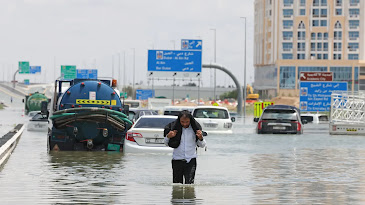Following the heaviest rainfall in 75 years in the United Arab Emirates, chaos unfolded as the state experienced unprecedented flooding, traffic disruptions, and infrastructure damage. The storm, which dropped over 250 mm of rain in less than 24 hours in some regions, caused widespread disruption, including canceled flights, closed schools, and abandoned vehicles due to rising floodwaters.
This extreme weather phenomenon, attributed to climate change, marked a significant departure from historical records dating back to 1949. Other countries in the region, such as Oman and Iran, also grappled with severe flooding and tragic casualties as a result of the powerful storm system moving across the Arabian Peninsula. Such events serve as a stark reminder of the increasing frequency and intensity of extreme weather events in the context of a changing global climate.
Extreme Blame Climate Change In Dubai Floods And Heavy rain UAE
Chaos erupted in the United Arab Emirates following the heaviest rainfall in 75 years, as stated by the country’s media office on Wednesday. Some regions experienced over 250 mm (approximately 10 inches) of precipitation in less than 24 hours. This unprecedented rainfall caused streets to flood, palm trees to be uprooted, and building facades to shatter. The impact was particularly severe in Dubai, a popular tourist destination, where flights were canceled, traffic came to a standstill, and schools were closed.
Within a span of just 12 hours on Tuesday, 100 mm (nearly 4 inches) of rain fell, according to weather observations at the airport. This amount is roughly equivalent to what Dubai typically receives in an entire year, according to data from the United Nations. The intensity and speed of the rainfall forced some motorists to abandon their vehicles as floodwaters rose,
transforming roads into rivers.These extreme rainfall events are becoming more frequent due to the warming of the atmosphere caused by
human-driven climate change. A warmer atmosphere has the capacity to absorb more moisture, similar to a towel, and release it in the form of heavy rainfall, leading to flooding.
The weather conditions were linked to a larger storm system that moved across the Arabian Peninsula and the Gulf of Oman. This same system also brought unusually wet weather to neighboring Oman and southeastern Iran. In Oman, heavy rain triggered flash floods that resulted in the loss of at least 18 lives, including schoolchildren, according to the country’s National Committee for Emergency Management. In the UAE’s Ras Al-Khaimah, a 70-year-old man lost his life after his vehicle was swept away by flooding, as reported by the police.
On Wednesday,
the rainfall shifted eastward, affecting parts of southern Iran and Pakistan, regions that typically receive minimal rainfall during this time of year. The southernmost city of Chabahar in Iran’s Sistan and Baluchestan province recorded 130 mm of rain.
Individuals attempting to travel by road into the central region faced significant challenges due to the adverse
weather conditions.








